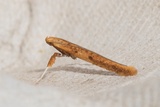Caloptilia betulicola (Hering, 1928) Species
Last modified: Dec. 10, 2025, 1:37 p.m.
A rare species in Belgium.
Details
- Classification
- Family: Gracillariidae > Subfamily: Gracillariinae > Tribus: Gracillariini > Genus: Caloptilia > Species: Caloptilia betulicola
- Vernacular names
- Bruine berkensteltmot (NL), Red birch slender (EN), Birken-Blatttütenmotte (DE)
- First mention in Belgium
- Van Daele E. & Pelerents C. 1969. Synthèse des observations effectuées pendant quatre années sur les lépidoptères nocturnes de la région horticole gantoise. — Mededelingen Rijksfaculteit Landbouwwetenschappen Gent 34: 31–56. On page 36.
- Status
-
Native
Distribution
Caterpillar
Whitish with pale brown head; pronotum without black spots.
Mine
The first instars make a narrow serpentine mine on the underside of the leaf. Later on, they continue with a brownish blotch, most of the time in the corner between two leaf veins. Rarely also upperside mines occur. Frass is deposited in a corner of the mine. In later instars the free living caterpillar leaves its mine and constructs two consecutive leaf rolls, the first one a short roll or just a tipped-over leaf edge, the second time a larger roll downwards turned and starting from the leaf tip occupying in many cases the whole leaf.
See also gracillariidae.net and bladmineerders.be.
Cocoon/pupa
A transparant, shining, greenish white cocoon at the underside of a leaf, most of the time situated near the leaf edge.
Bionomics
The larvae prefer young trees or just sapplings where they mine the leaves. After the mining stadium, the later instars leave the mine and construct two consecutive leaf rolls, the first one a short roll or just a tipped-over leaf edge, the second time a larger roll turned downwards and starting from the leaf tip occupying in many cases the whole leaf. The exuvium protrudes from the mine after the emergence of the adult. The adults hibernate.
Flight periods
The adults fly in two generations a year in June and from September to April of the next year.
Observed on
- Host plant (species):
- Betula pendula and Betula pubescens
Monophagous on Betula.


